Related Research Articles

Marino Marini was an Italian sculptor.

Maurits Cornelis Escher was a Dutch graphic artist who made mathematically inspired woodcuts, lithographs, and mezzotints. Despite wide popular interest, Escher was for most of his life neglected in the art world, even in his native Netherlands. He was 70 before a retrospective exhibition was held. In the late twentieth century, he became more widely appreciated, and in the twenty-first century he has been celebrated in exhibitions around the world.

The Penrose triangle, also known as the Penrose tribar, the impossible tribar, or the impossible triangle, is a triangular impossible object, an optical illusion consisting of an object which can be depicted in a perspective drawing, but cannot exist as a solid object. It was first created by the Swedish artist Oscar Reutersvärd in 1934. Independently from Reutersvärd, the triangle was devised and popularized in the 1950s by psychiatrist Lionel Penrose and his son, prominent Nobel Prize-winning mathematician Sir Roger Penrose, who described it as "impossibility in its purest form". It is featured prominently in the works of artist M. C. Escher, whose earlier depictions of impossible objects partly inspired it.
An impossible object is a type of optical illusion that consists of a two-dimensional figure which is instantly and naturally understood by the retina as representing a projection of a three-dimensional object.

Paul Klee was a Swiss-born German artist. His highly individual style was influenced by movements in art that included expressionism, cubism, and surrealism. Klee was a natural draftsman who experimented with and eventually deeply explored color theory, writing about it extensively; his lectures Writings on Form and Design Theory, published in English as the Paul Klee Notebooks, are held to be as important for modern art as Leonardo da Vinci's A Treatise on Painting for the Renaissance. He and his colleague, Russian painter Wassily Kandinsky, both taught at the Bauhaus school of art, design and architecture in Germany. His works reflect his dry humor and his sometimes childlike perspective, his personal moods and beliefs, and his musicality.
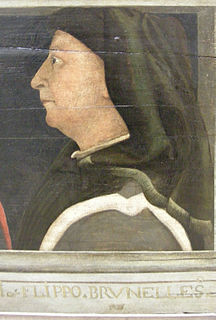
Filippo Brunelleschi, considered to be a founding father of Renaissance architecture, was an Italian architect, designer, and sculptor, and is now recognized to be the first modern engineer, planner, and sole construction supervisor. In 1421, Brunelleschi became the first person to receive a patent in the Western world. He is most famous for designing the dome of the Florence Cathedral, a feat of engineering that had not been accomplished since antiquity, as well as the development of the mathematical technique of linear perspective in art which governed pictorial depictions of space until the late 19th century and influenced the rise of modern science. His accomplishments also include other architectural works, sculpture, mathematics, engineering, and ship design. His principal surviving works can be found in Florence, Italy.

Andrea Mantegna was an Italian painter, a student of Roman archeology, and son-in-law of Jacopo Bellini.

Victor Vasarely, was a Hungarian-French artist, who is widely accepted as a "grandfather" and leader of the Op art movement.

Renaissance art is the painting, sculpture, and decorative arts of the period of European history known as the Renaissance, which emerged as a distinct style in Italy in about AD 1400, in parallel with developments which occurred in philosophy, literature, music, science, and technology. Renaissance art took as its foundation the art of Classical antiquity, perceived as the noblest of ancient traditions, but transformed that tradition by absorbing recent developments in the art of Northern Europe and by applying contemporary scientific knowledge. Along with Renaissance humanist philosophy, it spread throughout Europe, affecting both artists and their patrons with the development of new techniques and new artistic sensibilities. For art historians, Renaissance art marks the transition of Europe from the medieval period to the Early Modern age.
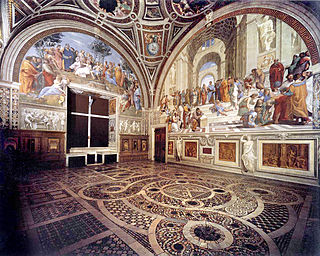
In art history, the High Renaissance was a short period of the most exceptional artistic production in the Italian states, particularly Rome, capital of the Papal States, and in Florence, during the Italian Renaissance. Most art historians state that the High Renaissance started around 1495 or 1500 and ended in 1520 with the death of Raphael, although some say the High Renaissance ended about 1525, or in 1527 with the Sack of Rome by the army of Charles V, Holy Roman Emperor, or about 1530. The best-known exponents of painting, sculpture and architecture of the High Renaissance include Leonardo da Vinci, Michelangelo, Raphael, and Bramante. In recent years, the use of the term has been frequently criticized by some academic art historians for oversimplifying artistic developments, ignoring historical context, and focusing only on a few iconic works.
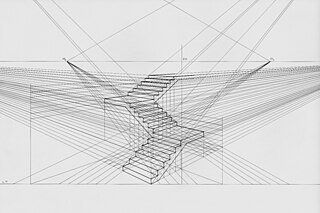
Linear or point-projection perspective is one of two types of graphical projection perspective in the graphic arts; the other is parallel projection. Linear perspective is an approximate representation, generally on a flat surface, of an image as it is seen by the eye. The most characteristic features of linear perspective are that objects appear smaller as their distance from the observer increases, and that they are subject to foreshortening, meaning that an object's dimensions along the line of sight appear shorter than its dimensions across the line of sight. All objects will recede to points in the distance, usually along the horizon line, but also above and below the horizon line depending on the view used.
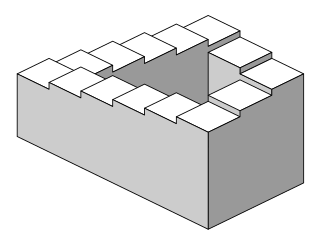
The Penrose stairs or Penrose steps, also dubbed the impossible staircase, is an impossible object created by Oscar Reutersvärd in 1937 and later independently made popular by Lionel Penrose and his son Roger Penrose. A variation on the Penrose triangle, it is a two-dimensional depiction of a staircase in which the stairs make four 90-degree turns as they ascend or descend yet form a continuous loop, so that a person could climb them forever and never get any higher. This is clearly impossible in three-dimensional Euclidean geometry.

Oscar Reutersvärd was a Swedish graphic artist, who in 1934 pioneered the art of 3D drawings that may initially appear feasible, yet cannot be physically constructed. He is sometimes described as "the father of the impossible figure", although there are much older examples, e.g. Hogarth's Satire on False Perspective, in addition to more recent well known example of the Penrose triangle and some others.

The Galleria dell'Accademia di Firenze, or "Gallery of the Academy of Florence", is an art museum in Florence, Italy. It is best known as the home of Michelangelo's sculpture David. It also has other sculptures by Michelangelo and a large collection of paintings by Florentine artists, mostly from the period 1300–1600, the Trecento to the Late Renaissance. It is smaller and more specialized than the Uffizi, the main art museum in Florence. It adjoins the Accademia di Belle Arti or academy of fine arts of Florence, but despite the name has no other connection with it.

Anamorphosis is a distorted projection requiring the viewer to occupy a specific vantage point, use special devices, or both to view a recognizable image. It is used in painting, photography, sculpture and installation, toys, and film special effects. The word is derived from the Greek prefix ana-, meaning "back" or "again", and the word morphe, meaning "shape" or "form". Extreme anamorphosis has been used by artists to disguise caricatures, erotic and scatological scenes, and other furtive images from a casual spectator, while revealing an undistorted image to the knowledgeable viewer.
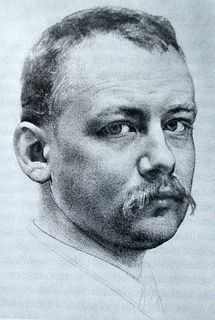
Karl Stauffer, known as Karl Stauffer-Bern was a Swiss painter, etcher and sculptor.

Mathematics and art are related in a variety of ways. Mathematics has itself been described as an art motivated by beauty. Mathematics can be discerned in arts such as music, dance, painting, architecture, sculpture, and textiles. This article focuses, however, on mathematics in the visual arts.

The Accademia delle Arti del Disegno, or "Academy of the Arts of Drawing", is an academy of artists in Florence, Italy. The Accademia e Compagnia delle Arti del Disegno, or "academy and company of the arts of drawing", was founded on 13 January 1563 by Cosimo I de' Medici, under the influence of Giorgio Vasari. It was made up of two parts: the Company was a kind of guild for all working artists, while the Academy was for more eminent artistic personalities of Cosimo’s court, and supervised artistic production in Tuscany. It was later called the Accademia delle Arti del Disegno.

Portrait of a Man with a Medal of Cosimo the Elder, also known as Portrait of a Youth with a Medal, is a tempera painting by Italian Renaissance painter Sandro Botticelli. The painting features a young man displaying in triangled hands a medal stamped with the likeness of Cosimo de' Medici. The identity of the young man has been a long-enduring mystery. Completed in approximately 1475, it is on display in the Uffizi Gallery of Florence.
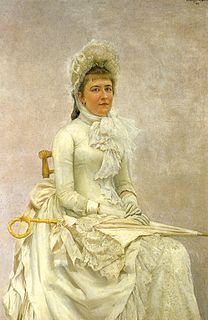
Lydia Welti Escher, was a Swiss patron of the arts and the daughter of Augusta Escher-Uebel (1838–1864) and Alfred Escher (1819–1882), among others the founder of the Gotthardbahn. Lydia Escher was one of the richest women of Switzerland in the 19th century, patron of the arts and established the Gottfried Keller Foundation.
References
- 1 2 3 Seckel, Al (2004), "Sandro Del-Prete (1937–) A Change Of Perspective", Masters of Deception: Escher, Dalí & the Artists of Optical Illusion, Sterling Publishing, ISBN 1-4027-0577-8
- ↑ Sandro del Prete-official website accessed 29 June 2017
- 1 2 del Prete, Sandro (2008). The Master of Illusions: Pictures to Ponder from a Visual Virtuoso. Sterling Publishing Company, Inc. ISBN 978-1-4027-5400-5.
- ↑ "Katalog der Deutschen Nationalbibliothek". Catalog of the German National Library.
- ↑ Feusi, Alois (11 October 2013). "Illusions-Museum weitet den Blick seiner Besucher". Neue Zuricher Zeitung. Retrieved 29 June 2017.
- ↑ Restaurant Kreuz in Hettiswil website accessed 29 June 2017